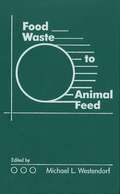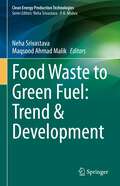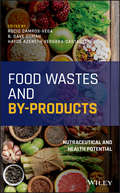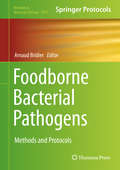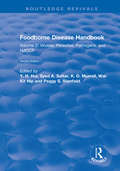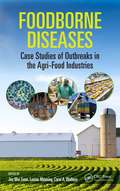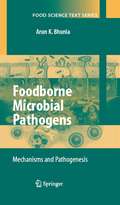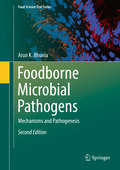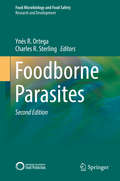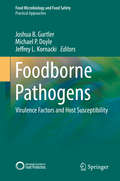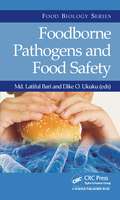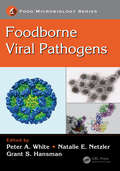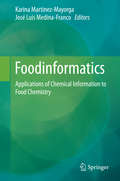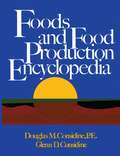- Table View
- List View
Food Traceability in Jordan: Current Perspectives (SpringerBriefs in Molecular Science)
by Moawiya A. Haddad Mohammed I. Yamani Da'san M.M. Jaradat Maher Obeidat Saeid M. Abu-Romman Salvatore ParisiThis book outlines the evolution of food traceability matters in the current traditional foods market and particularly with regard to selected historical foods based in Jordan.At present, traceability is just one of the many requirements the food industry is forced to meet. The topic can be approached from various angles: regulation, technological perspectives, food business operators, packaging manufacturers, software producers, and consumer views. In addition, traceable food products provide an interesting legacy for many geographical and ethnic cultures. Consequently, the examination of certain recipes or food products linked with history and traditions can make a unique and valuable contribution to future developments in this area.In this regard, Jordanian foods offer a prime example. This book examines three traditional products from different viewpoints, paying special attention to their chemical composition, the identification of raw materials, preparation procedures, and traceability. The book begins with a more general discussion on food traceability without detailed regional implications, while the second chapter discusses the product hummus in its many versions. In turn, the third and fourth chapters focus on two fermented dairy products, labaneh and jameed, and their connections with the Mediterranean diet. The book offers a valuable reference guide to many traditional/historical products in the Middle East, with a particular focus on traceability matters and solutions.
Food Wars: "The Global Battle for Mouths, Minds and Markets"
by Michael Heasman Tim Lang'Food Wars is a heartening book which calls for a radical change in the way the world feeds itself. It offers a blueprint for a future where nobody goes to bed hungry.' Derek Cooper, founder presenter of the BBC's Food Programme 'An important book that should be read by everyone who cares about how the way food is produced affects our own health as well as that of the environment and our national economies.' Marion Nestle, author of Food Politics, and Paulette Goddard Professor of Nutrition, Food Studies, and Public Health, New York University The emergence of global markets has a far-reaching impact on what we eat and on health, food security, social justice and quality of life. What matters now is not just what we eat, but how and where it has been produced, distributed and processed, and the assumptions upon which this production is based - a global politics of food and health. Food Wars argues that two conflicting paradigms (one developing food through integrating the 'life sciences', the other though 'ecology') are battling to replace the dominant industrial-productionist model of the 20th century, both grappling to attract investment, public support and policy legitimacy over the appropriate use of biology and food technologies.
Food Wars: "The Global Battle for Mouths, Minds and Markets"
by Michael Heasman Tim Lang'Food Wars is a heartening book which calls for a radical change in the way the world feeds itself. It offers a blueprint for a future where nobody goes to bed hungry.' Derek Cooper, founder presenter of the BBC's Food Programme 'An important book that should be read by everyone who cares about how the way food is produced affects our own health as well as that of the environment and our national economies.' Marion Nestle, author of Food Politics, and Paulette Goddard Professor of Nutrition, Food Studies, and Public Health, New York University The emergence of global markets has a far-reaching impact on what we eat and on health, food security, social justice and quality of life. What matters now is not just what we eat, but how and where it has been produced, distributed and processed, and the assumptions upon which this production is based - a global politics of food and health. Food Wars argues that two conflicting paradigms (one developing food through integrating the 'life sciences', the other though 'ecology') are battling to replace the dominant industrial-productionist model of the 20th century, both grappling to attract investment, public support and policy legitimacy over the appropriate use of biology and food technologies.
Food Wars: The Global Battle for Mouths, Minds and Markets
by Tim Lang Michael HeasmanIn the years since publication of the first edition of Food Wars much has happened in the world of food policy. This new edition brings these developments fully up to date within the original analytical framework of competing paradigms or worldviews shaping the direction and decision-making within food politics and policy. The key theme of the importance of integrating human and environmental health has become even more pressing. In the first edition the authors set out and brought together the different strands of emerging agendas and competing narratives. The second edition retains the same core structure and includes updated examples, case studies and the new issues which show how these conflicting tendencies have played out in practice over recent years and what this tells us about the way the global food system is heading. Examples of key issues given increased attention include: nutrition, including the global rise in obesity, as well as chronic conditions, hunger and under-nutrition the environment, particularly the challenges of climate change, biodiversity loss, water stress and food security food industry concentration and market power volatility and uncertainty over food prices and policy responses tensions over food, democracy and citizenship social and cultural aspects impacting food and nutrition policies.
Food Wars: The Global Battle for Mouths, Minds and Markets
by Tim Lang Michael HeasmanIn the years since publication of the first edition of Food Wars much has happened in the world of food policy. This new edition brings these developments fully up to date within the original analytical framework of competing paradigms or worldviews shaping the direction and decision-making within food politics and policy. The key theme of the importance of integrating human and environmental health has become even more pressing. In the first edition the authors set out and brought together the different strands of emerging agendas and competing narratives. The second edition retains the same core structure and includes updated examples, case studies and the new issues which show how these conflicting tendencies have played out in practice over recent years and what this tells us about the way the global food system is heading. Examples of key issues given increased attention include: nutrition, including the global rise in obesity, as well as chronic conditions, hunger and under-nutrition the environment, particularly the challenges of climate change, biodiversity loss, water stress and food security food industry concentration and market power volatility and uncertainty over food prices and policy responses tensions over food, democracy and citizenship social and cultural aspects impacting food and nutrition policies.
Food Waste Conversion (Methods and Protocols in Food Science)
by Cristobal N. Aguilar Gonzalez Ricardo Gómez-García Mohammed KuddusThis volume provides protocols on food waste conversion through the use of novel food processing. Chapters guide readers through tools on the food manufacturing processes, sustainability, new food products, food waste minimization, re-valorization of food residues. All chapters will include an introduction to the respective topic, lists of all necessary materials and reagents, easily reproducible laboratory protocols, and notes on how to avoid or solve typical problems. Authoritative and cutting-edge, Food Waste Conversion aims to give a comprehensive introduction into methods and proceduresrelated to food waste conversion.
Food Waste to Animal Feed
by Michael L. WestendorfThe magnitude of the food-waste disposal problem cannot be understated. Utilisation of food waste is of concern to the food processing industry, consumers, environmentalists, and regulators of handling and disposal systems. Food waste is not consistent in quality, is usually high in moisture content, and is only available locally. This book focuses on the challenges of utilising both wet and/or processed food waste. The regulatory environment relating to food waste, the perspective of the end-users, and practical use as animal feed is also discussed. One of the goals of this publication, other than to give a clear explanation of the subject of food waste and its uses as animal feed, is to stimulate a need for research.
Food Waste to Green Fuel: Trend & Development (Clean Energy Production Technologies)
by Neha Srivastava Maqsood Ahmad MalikThis edited book covers all the existing possibilities of using food waste as a potential, alternative and ‘ready to use’, feed stock for biofuels production. Moreover, it also presents all the sustainable and economically feasible biofuels option with their details strategies, mechanism, advantages, draw backs and future scope. It also explores in depth knowledge of food waste, and details the processing as well as opportunities to utilize it at for mass scale biofuels production. The practical feasibility and economic sustainability of biofuels production is still suffering with its cost intensity and lack of rigorous scientific strategies as well as inputs to explore it on further at upscale level. Low cost, carbon rich, economic and environmental friendly feedstock, may have strong possibilities to reduce the overall biofuels production cost and the book is based on this strategy. The book is of interest to academicians and researchers interested in industries related to biofuels production, food processing industries and industries related to waste valorization.
Food Wastes and By-products: Nutraceutical and Health Potential
by Rocio Campos-Vega B. Dave Oomah Haydé Azeneth Vergara‐CastañedaA complete guide to the evolving methods by which we may recover by-products and significantly reduce food waste Across the globe, one third of cereals and almost half of all fruits and vegetables go to waste. The cost of such waste – both to economies and to the environment – is a serious and increasing concern within the food industry. If we are to overcome this crisis and move towards a sustainable future, we must do everything possible to utilize innovative new methods of extracting and processing valuable by-products of all kinds. Food Wastes and By-products represents a complete primer to this important and complex process. Edited and written by leading researchers, the text provides essential information on the supply of waste and its composition, identifies foods rich in valuable bioactive compounds, and explores revolutionary methods for creating by-products from fruit, vegetable, and seed waste. Other chapters discuss the nutraceutical properties of value-added by-products and their uses in the manufacturing of dietary fibers, food flavors, supplements, pectin, and more. This book: Explains how reconstituted by-products can best be used to radically reduce food waste Discusses the potential nutraceutical assets of recovered food waste Covers a broad range of by-product sources, such as mangos, cacao, flaxseed, and spent coffee grounds Describes novel extraction processes and the emerging use of nanotechnology A significant contribution to the field, Food Wastes and By-products is a timely and essential resource for food industry professionals, government agencies and NGOs involved in nutrition, agriculture, and food production, and university instructors and students in related areas.
Food Wastes and By-products: Nutraceutical and Health Potential
by Rocio Campos-Vega B. Dave Oomah Hayde Azeneth Vergara-CastanedaA complete guide to the evolving methods by which we may recover by-products and significantly reduce food waste Across the globe, one third of cereals and almost half of all fruits and vegetables go to waste. The cost of such waste – both to economies and to the environment – is a serious and increasing concern within the food industry. If we are to overcome this crisis and move towards a sustainable future, we must do everything possible to utilize innovative new methods of extracting and processing valuable by-products of all kinds. Food Wastes and By-products represents a complete primer to this important and complex process. Edited and written by leading researchers, the text provides essential information on the supply of waste and its composition, identifies foods rich in valuable bioactive compounds, and explores revolutionary methods for creating by-products from fruit, vegetable, and seed waste. Other chapters discuss the nutraceutical properties of value-added by-products and their uses in the manufacturing of dietary fibers, food flavors, supplements, pectin, and more. This book: Explains how reconstituted by-products can best be used to radically reduce food waste Discusses the potential nutraceutical assets of recovered food waste Covers a broad range of by-product sources, such as mangos, cacao, flaxseed, and spent coffee grounds Describes novel extraction processes and the emerging use of nanotechnology A significant contribution to the field, Food Wastes and By-products is a timely and essential resource for food industry professionals, government agencies and NGOs involved in nutrition, agriculture, and food production, and university instructors and students in related areas.
Foodborne Bacterial Pathogens: Methods and Protocols (Methods in Molecular Biology #1918)
by Arnaud BridierThis volume presents a compilation of various representative techniques and approaches currently used to study bacterial foodborne pathogens. Chapters guide the reader through bacterial pathogen detection and quantification in food, molecular, phenotypic, metabolic characterization of food pathogens, and ecology of foodborne bacterial pathogens. Written in the highly successful Methods in Molecular Biology series format, chapters include introductions to their respective topics, lists of the necessary materials and reagents, step-by-step, readily reproducible laboratory protocols, and tips on troubleshooting and avoiding known pitfalls.Authoritative and cutting-edge, Foodborne Bacterial Pathogens : Methods and Protocols aims to server as a guide both for researchers, students, and those in the food industry who want to have an overview of current approaches and protocols used to study bacterial foodborne pathogens.
Foodborne Bacterial Pathogens: Methods and Protocols (Methods in Molecular Biology #2852)
by Arnaud BridierThis updated volume presents a compilation of various representative techniques and approaches currently used to study bacterial foodborne pathogens. Chapters guide the reader through bacterial pathogen detection and quantification in food, molecular, phenotypic, metabolic characterization of food pathogens, and ecology of foodborne bacterial pathogens. Written in the highly successful Methods in Molecular Biology series format, chapters include introductions to their respective topics, lists of the necessary materials and reagents, step-by-step, readily reproducible laboratory protocols, and key tips on troubleshooting and avoiding known pitfalls. Authoritative and cutting-edge, Foodborne Bacterial Pathogens: Methods and Protocols, Second Edition aims to ensure successful results in the further study of this vital field.
Foodborne Disease Handbook, Second Edition: Volume I: Bacterial Pathogens
by Y. H. HuiContains new chapters on the role of U. S. poison centers in bacterial exposures; bacteria biota in foods; salmonellosis in animals; human salmonellosis; vibro cholerae; vibrio vulnificus; and more.
Foodborne Disease Handbook, Second Edition: Volume I: Bacterial Pathogens
by Y. H. HuiContains new chapters on the role of U. S. poison centers in bacterial exposures; bacteria biota in foods; salmonellosis in animals; human salmonellosis; vibro cholerae; vibrio vulnificus; and more.
Foodborne Diseases: Case Studies of Outbreaks in the Agri-Food Industries
by Jan Mei Soon Louise Manning Carol A. WallaceFoodborne Diseases: Case Studies of Outbreaks in the Agri-Food Industries defines the context of foodborne disease across a range of food sectors. It provides insight into the causes and management of outbreaks along with practical lessons about foodborne disease prevention strategies relevant to stakeholders throughout the food supply chain. Indiv
Foodborne Microbial Pathogens: Mechanisms and Pathogenesis (Food Science Text Series)
by Arun BhuniaAt last, here is a graduate-level textbook that focuses on the very latest information on the molecular and cellular mechanism of several major foodborne bacterial pathogens. For the first time in the field, this book makes the link between foodborne illness and immunology. It also covers virulence genes and their regulation in the host or the food environment, pathogenicity testing models, clinical symptoms and prevention and control strategies. Unlike other textbooks this one also covers the host/parasite interaction to a level where readers have a real appreciation of the disease mechanism. It is imperative that we acquire a better understanding of foodborne pathogens. And this is what this brilliant and timely contribution to the subject offers.
Foodborne Microbial Pathogens: Mechanisms and Pathogenesis (Food Science Text Series)
by Arun K. BhuniaThis book primarily covers the general description of foodborne pathogens and their mechanisms of pathogenesis, control and prevention, and detection strategies, with easy-to-comprehend illustrations. The book is an essential resource for food microbiology graduate or undergraduate students, microbiology professionals, and academicians involved in food microbiology, food safety, and food defense-related research or teaching. This new edition covers the significant progress that has been made since 2008 in understanding the pathogenic mechanism of some common foodborne pathogens, and the host-pathogen interaction. Foodborne and food-associated zoonotic pathogens, responsible for high rates of mortality and morbidity, are discussed in detail. Chapters on foodborne viruses, parasites, molds and mycotoxins, and fish and shellfish are expanded. Additionally, chapters on opportunistic and emerging foodborne pathogens including Nipah virus, Ebola virus, Aeromonas hydrophila, Brucella abortus, Clostridium difficile, Cronobacter sakazakii, and Plesiomonas shigelloides have been added. The second edition contains more line drawings, color photographs, and hand-drawn illustrations.
Foodborne Parasites (Food Microbiology and Food Safety)
by Ynes R. OrtegaThis book examines the two major parasite groups that are transmitted via water or foods: the single-celled protozoa, and the helminths: cestodes (tapeworms), nematodes (round worms), and trematodes (flukes). Each chapter covers the biology, mechanisms of pathogenesis, epidemiology, treatment, and inactivation of these parasites. This important new text offers a better understanding of the biology and control of parasitic infections necessary to reduce or eliminate future outbreaks in the U.S. and elsewhere.
Foodborne Parasites (Food Microbiology and Food Safety)
by Ynés R. Ortega Charles R. SterlingThe globalization and commercialization of the food system has unintentionally led to the introduction of new foodborne parasites in countries worldwide. Fortunately, advances in detection and control are providing the basis for a better understanding of the biology and control of parasitic infections, and this in turn will likely contribute to the reduction and hopefully elimination of parasitic foodborne outbreaks. Building on the first edition, this completely revised second edition of Foodborne Parasites covers the parasites most associated with foodborne transmission and therefore of greatest global public health relevance. The volume examines protozoa and their subgroups: the amoeba, coccidia, flagellates and ciliates. Chapters also address Trypanosoma cruzi, recently recognized as an emerging foodborne protozoan. The helminth section is expanded to cover teniasis, cysticercosis, hydatidosis, and the trematodes and nematodes including Angiostrongylus, which is present worldwide. Finally, the editors examine the burden and risk assessment determinations that have provided a scientific framework for developing policies for the control of foodborne parasites.
Foodborne Pathogens: Virulence Factors and Host Susceptibility (Food Microbiology and Food Safety)
by Joshua B. Gurtler Michael P. Doyle Jeffrey L. KornackiFoodborne illnesses continue to be a major public health concern. All members of a particular bacterial genera (e.g., Salmonella, Campylobacter) or species (e.g., Listeria monocytogenes, Cronobacter sakazakii) are often treated by public health and regulatory agencies as being equally pathogenic; however, this is not necessarily true and is an overly conservative approach to ensuring the safety of foods. Even within species, virulence factors vary to the point that some isolates may be highly virulent, whereas others may rarely, if ever, cause disease in humans. Hence, many food safety scientists have concluded that a more appropriate characterization of bacterial isolates for public health purposes could be by virotyping, i.e., typing food-associated bacteria on the basis of their virulence factors. The book is divided into two sections. Section I, “Foodborne Pathogens and Virulence Factors,” hones in on specific virulence factors of foodborne pathogens and the role they play in regulatory requirements, recalls, and foodborne illness. The oft-held paradigm that all pathogenic strains are equally virulent is untrue. Thus, we will examine variability in virulence between strains such as Listeria, Salmonella, Campylobacter, Cronobacter, etc. This section also examines known factors capable of inducing greater virulence in foodborne pathogens. Section II, “Foodborne Pathogens, Host Susceptibility, and Infectious Dose” , covers the ability of a pathogen to invade a human host based on numerous extraneous factors relative to the host and the environment. Some of these factors include host age, immune status, genetic makeup, infectious dose, food composition and probiotics. Readers of this book will come away with a better understanding of foodborne bacterial pathogen virulence factors and pathogenicity, and host factors that predict the severity of disease in humans.
Foodborne Pathogens and Food Safety
by Latiful Bari Dike O. UkukuFoodborne pathogens continue to cause major public health problems worldwide and have escalated to unprecedented levels in recent years. In this book, major foodborne diseases and the key food safety issues are discussed elaborately. In addition, emerging and reemerging microbial agents and other food safety related topics are discussed. This book
Foodborne Viral Pathogens (Food Microbiology)
by Peter A. White Natalie E. Netzler Grant S. HansmanViral transmission through contaminated food and water claims hundreds of thousands of lives every year, particularly affecting children in developing nations. Foodborne viral pathogens are associated with gastroenteritis and hepatitis, causing widespread epidemics that affect all populations and demographics worldwide. Foodborne Viral Pathogens comprehensively covers the predominant etiological viral agents of foodborne disease, including norovirus, hepatitis A virus, hepatitis E virus, astrovirus, sapovirus and rotavirus, and several emerging viruses and prions. By improving food safety awareness and viral detection, and through promotion of global food safety standards, our ability to cope with and control foodborne disease will be enhanced. Foodborne Viral Pathogens includes a detailed review of the molecular biology, potential vaccines, and available antiviral treatments of all major foodborne viral pathogens and prions. Written by specialists and leading virologists, this book features techniques used for typing, viral detection, strategies for control, and viral risk assessments. This book is intended as a detailed handbook for food microbiology and medical applications and will be a useful guide for anyone with an interest in foodborne disease.
Foodborne Viral Pathogens (Food Microbiology)
by Peter A. White Natalie E. Netzler Grant S. HansmanViral transmission through contaminated food and water claims hundreds of thousands of lives every year, particularly affecting children in developing nations. Foodborne viral pathogens are associated with gastroenteritis and hepatitis, causing widespread epidemics that affect all populations and demographics worldwide. Foodborne Viral Pathogens comprehensively covers the predominant etiological viral agents of foodborne disease, including norovirus, hepatitis A virus, hepatitis E virus, astrovirus, sapovirus and rotavirus, and several emerging viruses and prions. By improving food safety awareness and viral detection, and through promotion of global food safety standards, our ability to cope with and control foodborne disease will be enhanced. Foodborne Viral Pathogens includes a detailed review of the molecular biology, potential vaccines, and available antiviral treatments of all major foodborne viral pathogens and prions. Written by specialists and leading virologists, this book features techniques used for typing, viral detection, strategies for control, and viral risk assessments. This book is intended as a detailed handbook for food microbiology and medical applications and will be a useful guide for anyone with an interest in foodborne disease.
Foodinformatics: Applications of Chemical Information to Food Chemistry
by Karina Martinez-Mayorga José Luis Medina-FrancoThe explosion in the generation of information parallels the explosion of computational resources. The use of computers to collect, store and manipulate chemical information is at the heart of chemoinformatics. These methodologies, whose main target thus far has been the pharmaceutical field, are general and can be applied to other types of chemical data sets, such as those containing food chemicals. While the use of chemical information methodologies to address food-related challenges is still in its infancy, interest is growing and will continue to do so as the methods prove useful, particularly for providing practical solutions to food industry challenges. Foodinformatics gives an overview of basic concepts, applications, tools and perspectives of the emerging field of foodinformatics. The book is an important addition to the literature and will be of interest of food chemists, nutritionists, informaticians and scientists of related fields. About the Editors Karina Martínez-Mayorga, Instituto de Química, UNAM, Mexico City, México and Torrey Pines Institute for Molecular Studies, Port St. Lucie, FL, USA José Luis Medina-Franco, Instituto de Química, UNAM, México City, México, and Torrey Pines Institute for Molecular Studies, Port St. Lucie, FL, USA




